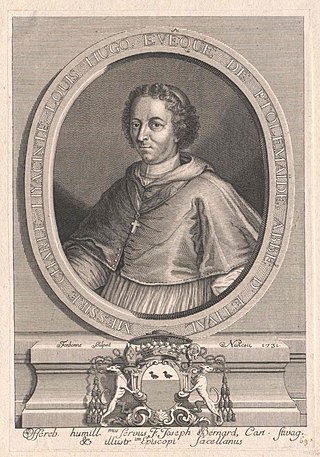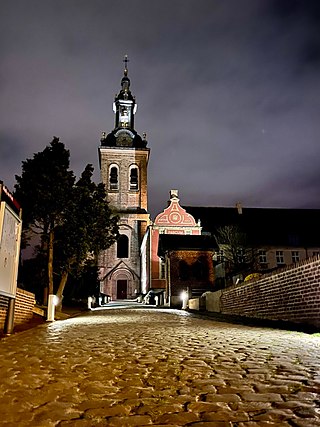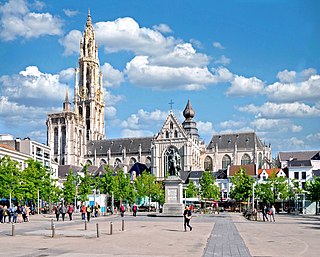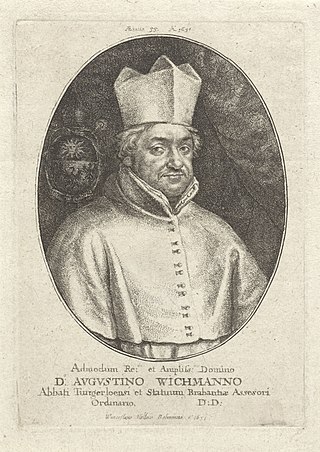

Jan Druys, Latinized Drusius (1568-1634) was a Norbertine canon regular from the Low Countries who became the 30th Abbot of Park Abbey in Heverlee just outside Leuven. [1] [2]


Jan Druys, Latinized Drusius (1568-1634) was a Norbertine canon regular from the Low Countries who became the 30th Abbot of Park Abbey in Heverlee just outside Leuven. [1] [2]
Druys was born at Kumtich, near Tienen, in 1568. [3] He studied successively at Sint-Truiden, Liège, Namur and Leuven. He entered the Norbertine Abbey of Park in 1587. Ordained priest, he was sent to the Norbertine College at the University of Leuven and obtained his licentiate in 1595.
Recalled to the abbey, he was made sub-prior and professor of theology to the young religious at the abbey, and chaplain to Abbot Ambrose Loots at the monastery's Refugium in Brussels, which was in frequent use during the troubled times at the end of the sixteenth century. At the death of Abbot Loots in 1601, Druys was elected as his successor. Four years later he was appointed vicar-general to the Abbot-General of Prémontré Abbey. He sat in the States of Brabant on behalf of the First Estate from 1604. [3]
The University of Leuven having suffered much from the religious and political disturbances of the time, Druys was in 1607 appointed, together with Stephanus van Craesbeke, a lay member of the Council of Brabant, as visitor to the university, with full power to reform abuses. The reforms that they recommended were approved in Brussels on 18 April 1607 and confirmed by Pope Paul V on 22 October the same year. [3] Druys was also made visitor to the University of Douai (1616) and to the Celestine monastery at Heverlee. In addition he restored and enlarged his own abbey, which had suffered much from the vandalism of the soldiers, and provided better educational advantages for his religious.
At the general chapter held at Prémontré in 1628, Abbot Druys was commissioned to revise the statutes of the order and conform them to the prescriptions of the Council of Trent, a revision which was approved at the general chapter of 1630. Druys prefixed a preface, "Praefatio ad omnes candidissimi et canonici ordinis religiosos", which Foppens characterizes as longam, piam, eruditam. He had a tree of the saints of the order made by the skilful engraver C. Mallery. He also published a small work entitled Exhortatio ad candidi ordinis religiosos.
Abbot Druys was deputed by the general chapter of 1630 to bring back several abbeys of Spain into union and observance, but was unsuccessful. While on this mission he conferred with Philip IV of Spain on the sad state of affairs in Brabant. A ring presented to him by this monarch is preserved at Park, as is also a letter from Henrietta Maria, Queen of England.
Druys was the second lord spiritual in the delegation of the States of Brabant to the Estates General of 1632, the first being Jacobus Boonen, Archbishop of Mechelen. [4]
He died on 25 March 1634.

Kortenberg is a Belgian municipality located in the province of Flemish Brabant, about halfway between the cities of Brussels and Leuven. The municipality comprises the subdivisions or deelgemeenten of Erps-Kwerps, Everberg, Kortenberg proper and Meerbeek. On 1 January 2013 Kortenberg had a total population of 19,393. The total area is 34.52 km² which gives a population density of about 562 inhabitants per km². In the southern part of Everberg there is also a hamlet called Vrebos, while between Erps-Kwerps and Meerbeek there is another hamlet called Schoonaarde, which can be found in the proximity of the train station of Erps-Kwerps.

The Order of Canons Regular of Prémontré, also known as the Premonstratensians, the Norbertines and, in Britain and Ireland, as the White Canons, is a religious order of canons regular of the Catholic Church founded in Prémontré near Laon in 1120 by Norbert of Xanten, who later became Archbishop of Magdeburg. Premonstratensians are designated by OPraem following their name.

Affligem Abbey is a Benedictine abbey in the municipality of Affligem, Flemish Brabant, Belgium, 19 km (12 mi) to the north-west of Brussels. Dedicated in 1086, it was the most important monastery in the Duchy of Brabant and therefore often called Primaria Brabantiae.

Averbode Abbey is a Premonstratensian abbey situated in Averbode, in the municipality Scherpenheuvel-Zichem, in the Archdiocese of Mechelen-Brussels in Belgium. It was founded about 1134, suppressed in 1797, and reestablished in 1834. Throughout the 20th century the abbey press was a leading children's publisher in Belgium. The church's building is a peculiar synthesis of Baroque and Gothic, with Renaissance ornament details, dominating the monastery complex. The whole structure was built of iron sandstone from Langdorp and white sandstone from Gobertange between 1664 and 1672, after a design by the Antwerp architect Jan Van den Eynde II.

Prémontré Abbey was the mother house of the Premonstratensian Order and was located at Prémontré about twelve miles west of Laon, département of Aisne, France.

Charles-Hyacinthe Hugo, also called Louis-Charles Hugo, was a Lorrain Premonstratensian author.

Park Abbey is a Premonstratensian abbey in Belgium, at Heverlee just south of Leuven, in Flemish Brabant.

Keizersberg Abbey, also known as Mont César Abbey is a Benedictine monastery on the hill Keizersberg or Mont César in the north of the university town of Leuven, Belgium.

The Diocese of Antwerp is a Latin Church ecclesiastical territory or diocese of the Catholic Church in Belgium. The diocese was restored in 1961. It is a suffragan in the ecclesiastical province of the metropolitan Archdiocese of Mechelen-Brussels. Its cathedra is found within the Cathedral of Our Lady.

Francis Wichmans (1596–1661), in religion Augustinus, was a Premonstratensian spiritual author, missionary, and abbot of Tongerlo Abbey. In the last capacity he sat in the First Estate of the States of Brabant.

Berne Abbey, a Dutch abbey of the Premonstratensians, or Norbertines, in Heeswijk, North Brabant, is a religious community in the Netherlands. It has 27 brothers and priests.

Dieleghem Abbey or Dielegem Abbey is a former abbey located in the Brussels municipality of Jette, Belgium.

Daylesford Abbey is a Roman Catholic monastery of Canons Regular of Premontre, located in Chester County, Pennsylvania, about 20 miles west of Philadelphia. The Abbey is named after Daylesford, Pennsylvania, where the Norbertine Fathers established the foundation that developed into the Abbey.

Koningshoeven Abbey is a monastery of the Trappists founded in 1881 in Berkel-Enschot in North Brabant, the Netherlands.

Oosteeklo Abbey was a Cistercian nunnery founded in Oosteeklo in 1217 and later moved to Ghent.

Ninove Abbey was a monastery of the Premonstratensian Order in the center of Ninove, in the province of East Flanders, Belgium. Only the abbey church now remains.

Macarius Simeomo or Simeomus, born Jean-Baptiste (1616–1676) was the 44th abbot of St. Michael's Abbey, Antwerp.
Bernardusdal Abbey was a house of Cistercian nuns originally established just outside Diest in the Duchy of Brabant, and later within the walls of the town itself.